 In November I am leading (along with James Cotton) a four-month part-time programme around micro-budget films. I want to ensure we’re teaching what is actually happening in the industry today, rather than outdated ideas or common misconceptions. So, being the data-driven fiend that I am, I have performed a number of studies into the topic.
In November I am leading (along with James Cotton) a four-month part-time programme around micro-budget films. I want to ensure we’re teaching what is actually happening in the industry today, rather than outdated ideas or common misconceptions. So, being the data-driven fiend that I am, I have performed a number of studies into the topic.
Today I’m sharing some of the results from a survey I conducted with 542 film industry business professionals who have attended Cannes, AFM or Berlin in the past five years. In summary…
- Across 542 film professionals, $396,000 was deemed the maximum budget for a micro-budget film
- The maximum budget for “low budget” films was $2.1million
- Film professionals in Africa feel that a film must be budgeted at least $3.4 million to be commercially viable
- The figure for film professionals in South America was just $1.2 million
What is a micro-budget film?
Currently in the UK, many people will regard £150,000 ($245,000) as the cutoff for a film to be classed as micro-budget film. This is in large part down to the fact that £150k is the maximum budget for a film to take advantage of the SEIS tax scheme (which protects ~78% of investors’ money). Film London’s Microwave micro-budget film scheme caps budgets at £150,000 ($245,000) and Creative England’s iFeatures is a “low budget” scheme at £350,000 ($573,000). I asked 542 film industry business professionals “In your opinion, what is the maximum budget for a film to still be classified as micro-budget film?” The average was $396,000 (£243,000). 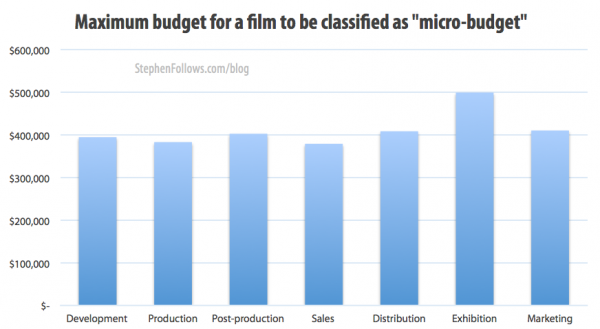
What is a “low budget” film?
In answer to the question “In your opinion, what is the maximum budget for a film to still be classified as low budget?” the average answer was $2.12 million (£1.38 million). 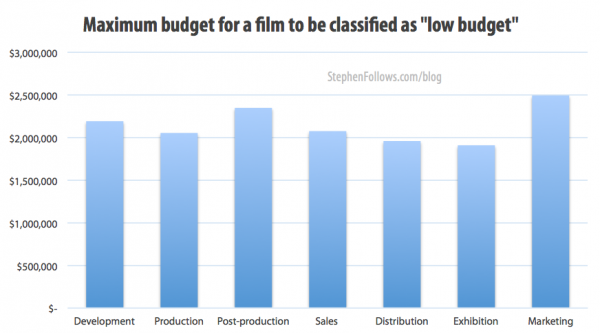
Do opinions of low and micro-budget film differ around the world?
Yes. My survey was completed by professionals from 66 countries and so I was able to compare the opinions from around the world. 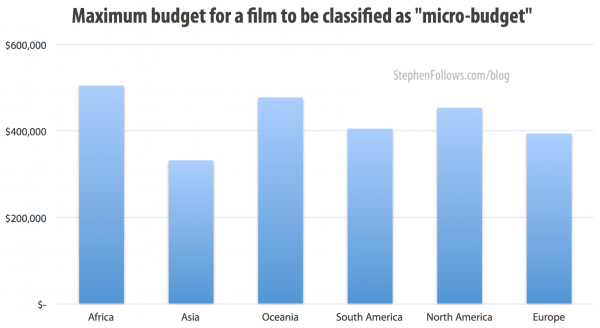
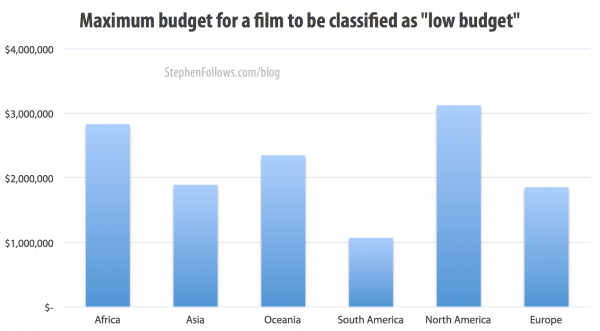
How much does it cost to make a “commercially viable” film?
The topic of what a film “should” cost is obviously highly subjective. I asked my respondents “What is lowest minimum budget you think realistically needs be spent in order to create a commercially viable film?” I have not produced a headline average figure as the opinions varied hugely. From the chart below you can see that respondents based in Africa and South America disagree by a factor of three. 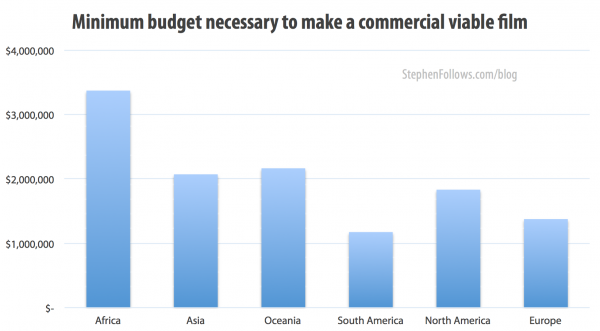
Country by country breakdown
Below you can see the averages for the top nine countries (i.e. countries with over 20 respondents). 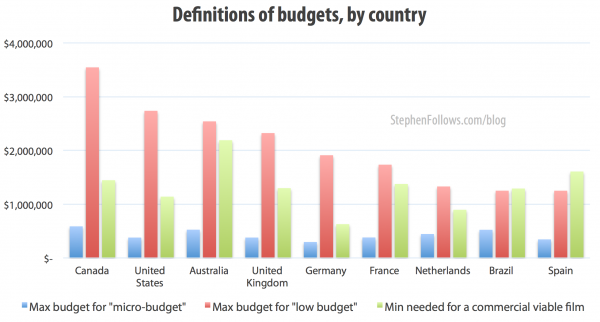
Epilogue
Part two of this survey will be released next week, when I will present the answers relating to the sales and distribution of low and micro-budget film. The averages I used here are ‘trimmed means’ which removes the highest 2% and lowest 2% of answers. This prevents extreme outliers from skewing the overall average and means that my average is from the middle 96% of answers.



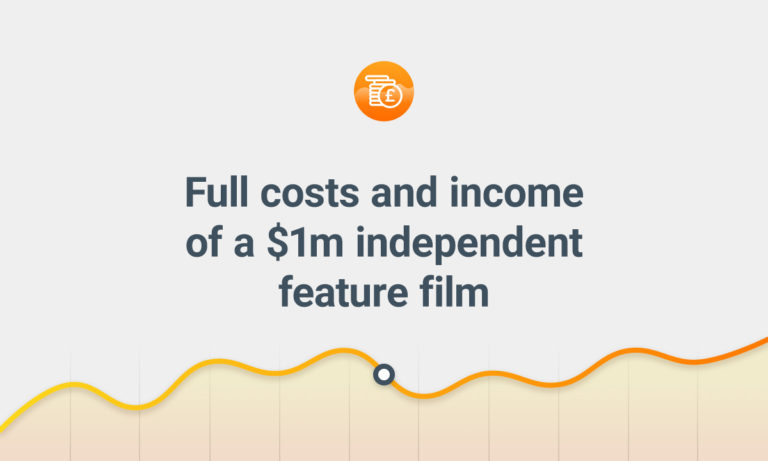

Comments
Oh WOW! How do you call budget of a film that is being made for one thousand pounds? Nano?
yeah…. nuclei maybe??? idk… im making one for less too…. maaaaaybe 5 grand if im lucky! :/ 1 million in canada for it to be a “viable film” though???? ugh.
Given the definitions here about what a “micro-budget” is, what about movies made for $1000? Where everybody is paid by net profit income, and where the biggest budget item is the food that’s served to cast and crew. Let’s get a definition of films made between $500 and $2000?
There is zero dollar budget film. Take your camera and start shooting with your family.
No nudget
What about USA indie film budgets?
This research was based on a survey, so it’s mostly about opinion with defining terms. To look at real budgets we need access to data. We get some of this is in the UK but sadly other countries don’t have the same rigorous data collection as the UK. The budget data on the UK industry I sometimes use on the blog comes from private tax filings, which only the UK authorities have access to. The BFI is then able to give out aggregate data whilst protecting private details.
Excellent article. On the one hand, it is discouraging that people equate money with quality when so many $300 million Hollywood blockbusters are horrendous. Then again, the challenge to make a film with little to know money is enticing, especially when one looks at micro-indies like HEAD TRAUMA, INK, RED VICTORIA, and PARANORMAL ACTIVITY.
You tell them! Some of these movies are pure trash with reiterated plots, mediocre characters and predictable outcomes.
Part two of this survey will be released next week, when I will present the answers relating to the sales and distribution of low and micro-budget film.
I can’t find the second part of the survey. That seems to me to be the far more valuable information.
Hi Drew., It’s here https://stephenfollows.com/what-makes-low-budget-films-sell. S
what kind of survey did you use? can we see the type of questions were asked?
Thank you
I just learned what “stan” means. I’m a Stan for my cousin Jessie Pinnick’s movie, “Princess Cyd.” (streaming on Amazon Prime Video, Hulu, and The Criterion Channel)
Stephen Cone, Director/Writer, made this Indie masterpiece with 180k in 18 days…….unheard of!
https://filmmakermagazine.com/103275-the-velocity-of-money/?fbclid=IwAR0vmv5ARZTAKNiqMwIrjaTsv9EApiFrc50SOaWlg0JE1vJuIJ7E4oK48Dc#.XzwR0kl7kWo
(“STAN” :is slang for someone who is a very zealous fan, especially of a celebrity or music group. Stan can also be a verb for liking something a great deal.
Where does stan come from?
The origin of stan, now widely used in fandom culture, may be surprising. In 2000, rapper Eminem released the single titled “Stan.“ The song and video are about a young man, named Stan, who is dangerously obsessed with Eminem. Stan displays his obsession in various ways, including adopting the rapper’s look, confessing to self-harm, and recording his eventual death with the intention to send it to Eminem.
One early person to use stan for an obsessed fan was the rapper Nas in a 2001 track where he raps: “You a fan, a phony, a fake, a pussy, a Stan.”
An Urban Dictionary entry describing stan for intense fandom was added in 2006, and one of the first tweets using stan as a verb for greatly liking someone came in 2008.
The slang spread online in the late 2000s and early 2010s, with stans of different fandoms arguing for the superiority of their interests. In 2010, the website Stan Wars launched because of these online arguments.